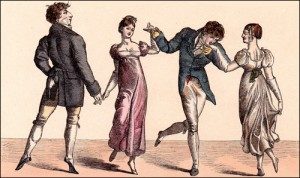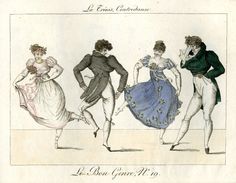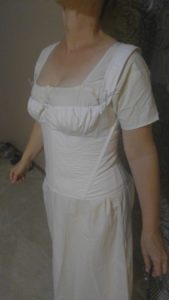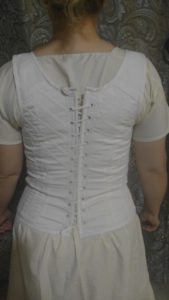by Donna Hatch
 1. It was not scandalous for ladies to show their ankles during the Regency Era. A number of Regency fashion plates and caricatures depict ladies revealing silk stocking-clad ankles and low-cut slippers, which were much like todays ballerina flat, while dancing, sitting, and walking. During the Victorian Era, shoe fashions changed from slippers to the Victorian boot. This happened about the same time that hemlines lowered and skirts widened. In addition to the Victorians following their monarch’s example of becoming exceedingly prudish, it eventually became scandalous for ladies to show ankles. However, during the Regency, it really was no big deal for ladies to hold up their narrow skirts to avoid a mud puddle or to allow greater freedom of movement to walk quickly, thus exposing ankles. Fun fact: It was, however, scandalous to say “legs.” Apparently “limbs” was the more accepted word in polite company.
1. It was not scandalous for ladies to show their ankles during the Regency Era. A number of Regency fashion plates and caricatures depict ladies revealing silk stocking-clad ankles and low-cut slippers, which were much like todays ballerina flat, while dancing, sitting, and walking. During the Victorian Era, shoe fashions changed from slippers to the Victorian boot. This happened about the same time that hemlines lowered and skirts widened. In addition to the Victorians following their monarch’s example of becoming exceedingly prudish, it eventually became scandalous for ladies to show ankles. However, during the Regency, it really was no big deal for ladies to hold up their narrow skirts to avoid a mud puddle or to allow greater freedom of movement to walk quickly, thus exposing ankles. Fun fact: It was, however, scandalous to say “legs.” Apparently “limbs” was the more accepted word in polite company.
 2. A dance set at the ball included two dances, not just one. When a gentleman asked a lady to “stand up with him” they were committed to 20 to 30 minutes together. Of course, country dances were all the rage which allowed couples to change partners frequently during the course of the dance, so they weren’t truly “stuck” together much. This practice of dancing sets of two is partly why a gentleman seldom asked a lady for two dances, meaning two dance sets, and never three unless they were engaged, because it basically tied them up together for most of the evening, giving little opportunity for other partnering.
2. A dance set at the ball included two dances, not just one. When a gentleman asked a lady to “stand up with him” they were committed to 20 to 30 minutes together. Of course, country dances were all the rage which allowed couples to change partners frequently during the course of the dance, so they weren’t truly “stuck” together much. This practice of dancing sets of two is partly why a gentleman seldom asked a lady for two dances, meaning two dance sets, and never three unless they were engaged, because it basically tied them up together for most of the evening, giving little opportunity for other partnering.

3. An evening at the theatre lasted most of the night. The main production was the play. However, after the main event, the theatre performed a light “afterpiece” – usually a comedy in the form of a pantomime or one-act play. A few theaters performed one short production prior to the main performance as well so there might be as many as three performances. With all these performances and intermissions, one expected to be at a London theater half of the night. Some patrons came and went, but many stayed all night, I suspect to people-watch rather than to enjoy the arts.

4. A fashionable lady’s unmentionables likely did not include drawers or pantalettes. With the narrow, slender gowns fashionable during the Regency resembling statues dating back to ancient Rome, bulky drawers with drawstring waists would have messed up the silhouettes of ladies’ gowns. Also, I have not found evidence that ladies wore pantalettes during previous eras either. The only women who wore drawers or pantalettes during Georgian and Regency England were prostitutes who wore them underneath their slitted skirts. Ahem. And that’s all I care to say regarding the matter. During the Victorian Era, ladies began wearing drawers or pantalettes underneath their wide bell-shape skirts, possibly to preserve modesty should the skirt accidentally tip upwards too far. Oh my! Later, this garment was also known as “pantaloons,” however Georgian and Regency pantaloons were men’s knee-length breeches.

5. It is a common myth that Regency ladies often fainted because their corsets were too tight. First of all, ladies during the Regency wore stays, not corsets. The difference is the shape and boning. Previous era corsets were made to cinch the waist. Regency stays, much more flexible and comfortable, were made to smooth and support. I’ve worn a corset and it is possible to feel truly uncomfortable if it is cinched up way too tightly. I even got a small bruise on my lowest rib on one side from having it laced tighter than it should have. What can I say? It was steampunk party and I wore it tighter than I would have it I’d planned to wear it all day. But I digress. I have also worn authentic Regency stays and they are so comfortable and well fitting that if they were easier to get into and out of (where’s my maid when I need her?), I would wear them every day.

I hope you enjoyed my fun facts. Comments and questions are welcome!

I like these little tidbits and pictures. It gives me a better idea eof what these articles look like. Thank you.
I’m so glad you enjoy my trivia, Gina. Thanks so much for your kind words!
I love your blog! So much interesting information! Keep it coming, please.
Thank you so much, Heidi! I’m happy you enjoy it and I appreciate you telling me!
I enjoyed it too. Always wondered about their clothing and undergarments.